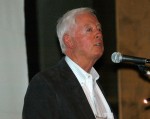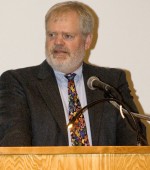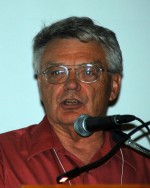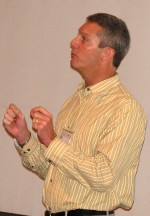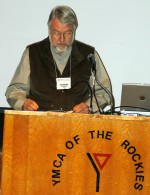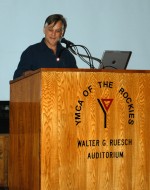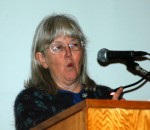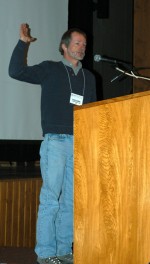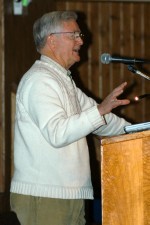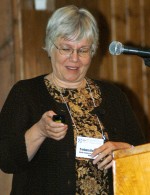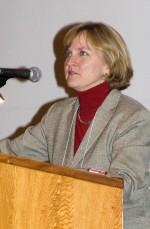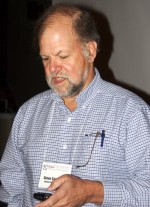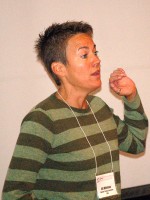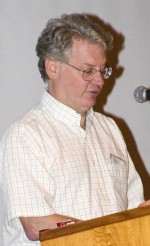More than 700 scientists and students from across the United States and their international colleagues attended the four day meeting, whose official theme was: The next 25 years of LTER: Contributions to understanding ecological change.
Attendees singled out the LTER Network Office which, under the stewardship of Bob Waide, organized and oversaw the meeting, for particular praise, noting that the meeting's organization had been superb.
Following the successful conclusion of the ASM, the Science Council (SC) asked John Magnuson (interim chair of the SC) to draft a resolution of appreciation to the organizers of the meeting. The resolution stated: "The LTER Science Council commends Bob Waide and the staff of the Network Office for the many contributions to this excellent All Scientists Meeting. Thank you all for your enthusiasm and diverse talents."
According to Dr. Waide, the ASM represents one of the LTER network's most effective mechanisms to promote team building for cross-site research and synthesis. The three to four day meetings focus the LTER scientific community on new challenges, result in the formation of new research collaborations, help integrate new sites and scientists into the LTER community, and provide the only opportunity for community-wide discussions of the future of the LTER program. "In contrast to a typical professional conference, an All Scientists Meeting focuses less on the presentation of individual research results and more on brainstorming, discussion, and synthesis of results across different ecosystems," Waide observed. Moreover, "All Scientists Meetings present excellent opportunities to share expertise, to transfer technology among sites, and to generate new scientific concepts, approaches, and experiments. They are, in short, the 'town hall meeting' for the LTER research community."
Contributing to the overall success of the meeting was, without doubt, the general setting and ambience of Estes Park, a venue that had been used for two previous successful ASMs. Located 8000 feet above sea level in the picturesque Colorado Rockies, with breathtaking scenery, snow capped mountain peaks, and cool, crisp air.
The YMCA management provided both accommodation and meals, further contributing to the smooth running of the meeting since participants did not waste time searching for restaurants and eating places. This left many participants with ample time and opportunity to go hiking and mountain climbing in between, before or after the various plenary, committee, or work group sessions.
Within the YMCA grounds participants routinely shared footpaths with the abundant but fairly tame wildlife, which roamed the lawns and could be spotted grazing outside the cabins. Sometimes the extremely close encounters between the human species and their animal counterparts, notably the Elk, was equally exciting as it was unsettling-like when one passed within inches of and looked into the eyes of a bull elk guarding his harem of cows.
However, the small town of Estes Park was only a few minutes away and a few participants found their way to the local dancing halls on one or two occasions.
The meeting proper was a combination of plenary sessions, working groups, committee meetings, mixers, and poster displays. Discussions ranged from topics such as the importance of long-term research in understanding ecological and social change, the ecosystem responses to atmospheric pollutants in and around cities, to the rapid decline in sea ice off the west Antarctic Peninsula and the geochemical evidence of increasing permafrost thaw in the Arctic.
The program included three plenary sessions that were addressed by Pamela Matson of Stanford University ("Integrative approaches to the study and management of human-environment systems"), Steve Carpenter of the North Temperate Lakes LTER ("Ecology for transformation"), and Ed Barbier of the University of Wyoming ("In the long run we are all dead: economics, history and long-term ecological change"), presentations on the origin, development and future of the LTER Network (Paul Risser, University of Oklahoma; Dick Marzolf, USGS retired; Caroline Bledsoe, UC Davis; and John Magnuson, University of Wisconsin), as well as addresses by representatives of the National Science Foundation (James Collins, the National Science Foundation's Assistant Director for Biological Sciences; Thomas Baerwald,, a program officer for social, behavioral and economic sciences; Henry Gholz, the LTER program officer at NSF; and former LTER chair, James Gosz, who currently advises the EPSCOR program at NSF).
Other presentations included opportunities for network-scale analyses that are emerging from the TRENDS in long-term ecological research project (led by Debra Peters, Jornada Basin LTER), a full day devoted to Research Planning and briefing on the accomplishments and future directions of the ongoing LTER strategic planning process (Scott Collins), and about 50 other working groups-including the Information Management committee and International LTER meetings and the LTER graduate student symposium.
After each plenary session, participants were free to attend any of a number of work groups or LTER standing committee meetings that ran concurrently.
The poster sessions and mixers were held together in the evenings, with the exception of the Information Managers (IM) and International LTER mixers. This format proved very popular, resulting in standing room only in the halls.
Among other interesting things was a trivia quiz, which was won by Stacie Kageyama (AND) and a photo contest, whose various categories were won by Amy Chiuchiolo (MCM-Scenery); Suzanne Remillard (AND-Wildlife (non-elk)); Carl Bowser (NTL-Elk); Hongyu Guo, Amy Kunza, Alana Lynes, and Sylvia Schaefer (GCE-Silly photos); Carl Bowser (LTER Scientists); Andrew Corbin (KBS-Posters); and McOwiti Thomas (LNO-Workgroups). You can view the winning photos at http://www.lternet.edu/asm/2006/photo_win.html.
Reports from the various committee and work groups can be found online on the ASM webpage http://www.lternet.edu/asm/2006/reports/.


 Enlarge this image
Enlarge this image